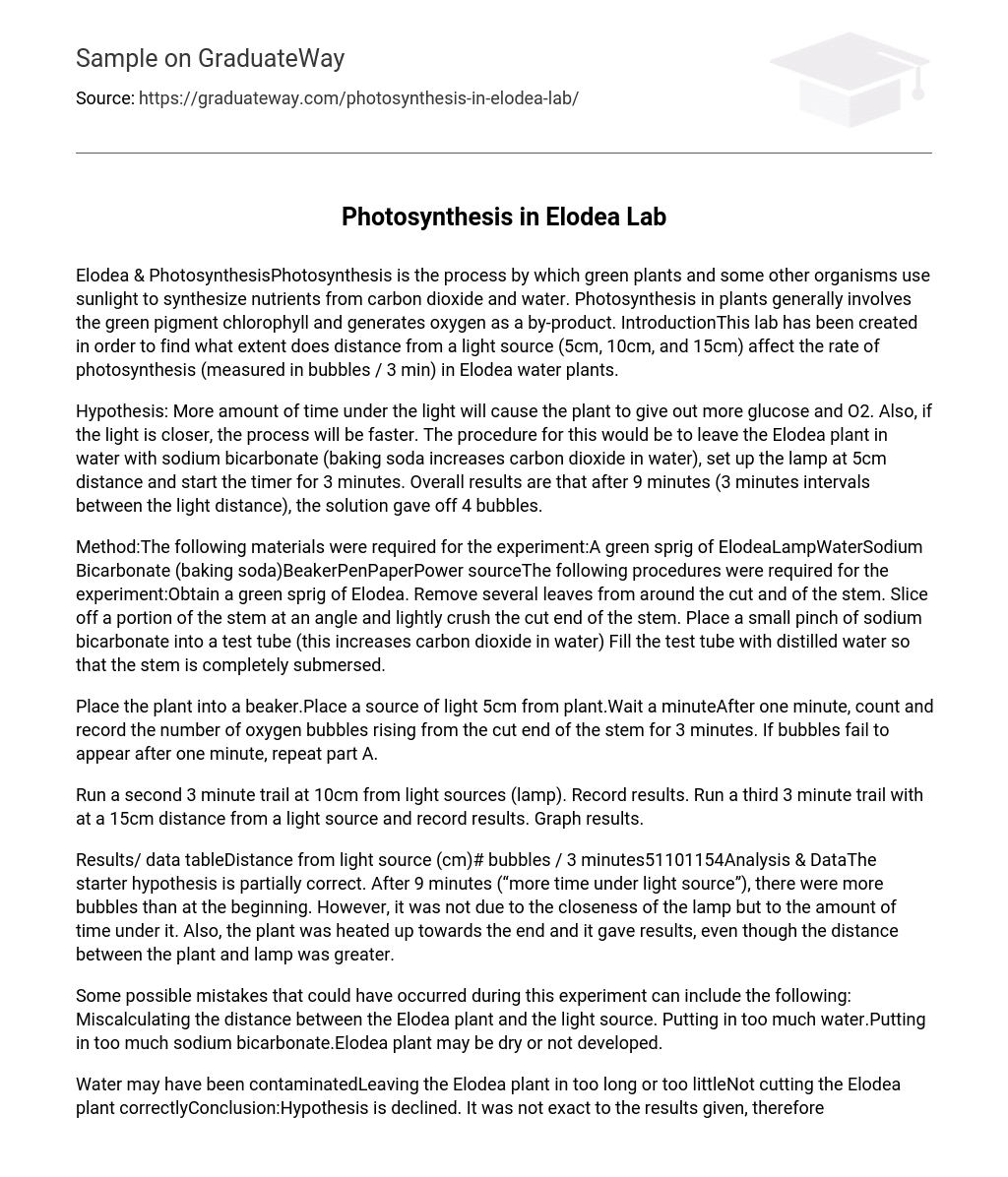Elodea & PhotosynthesisPhotosynthesis is the process by which green plants and some other organisms use sunlight to synthesize nutrients from carbon dioxide and water. Photosynthesis in plants generally involves the green pigment chlorophyll and generates oxygen as a by-product. IntroductionThis lab has been created in order to find what extent does distance from a light source (5cm, 10cm, and 15cm) affect the rate of photosynthesis (measured in bubbles / 3 min) in Elodea water plants.
Hypothesis: More amount of time under the light will cause the plant to give out more glucose and O2 . Also, if the light is closer, the process will be faster. The procedure for this would be to leave the Elodea plant in water with sodium bicarbonate (baking soda increases carbon dioxide in water), set up the lamp at 5cm distance and start the timer for 3 minutes. Overall results are that after 9 minutes (3 minutes intervals between the light distance), the solution gave off 4 bubbles.
Method:The following materials were required for the experiment:A green sprig of ElodeaLampWaterSodium Bicarbonate (baking soda)BeakerPenPaperPower sourceThe following procedures were required for the experiment:Obtain a green sprig of Elodea. Remove several leaves from around the cut and of the stem. Slice off a portion of the stem at an angle and lightly crush the cut end of the stem. Place a small pinch of sodium bicarbonate into a test tube (this increases carbon dioxide in water) Fill the test tube with distilled water so that the stem is completely submersed.
Place the plant into a beaker.Place a source of light 5cm from plant.Wait a minuteAfter one minute, count and record the number of oxygen bubbles rising from the cut end of the stem for 3 minutes. If bubbles fail to appear after one minute, repeat part A.
Run a second 3 minute trail at 10cm from light sources (lamp). Record results. Run a third 3 minute trail with at a 15cm distance from a light source and record results. Graph results.
Results/ data tableDistance from light source (cm)# bubbles / 3 minutes51101154Analysis & DataThe starter hypothesis is partially correct. After 9 minutes (“more time under light source”), there were more bubbles than at the beginning. However, it was not due to the closeness of the lamp but to the amount of time under it. Also, the plant was heated up towards the end and it gave results, even though the distance between the plant and lamp was greater.
Some possible mistakes that could have occurred during this experiment can include the following: Miscalculating the distance between the Elodea plant and the light source. Putting in too much water.Putting in too much sodium bicarbonate.Elodea plant may be dry or not developed.
Water may have been contaminatedLeaving the Elodea plant in too long or too littleNot cutting the Elodea plant correctlyConclusion:Hypothesis is declined. It was not exact to the results given, therefore I marked it incorrect. My hypothesis was that after a bigger amount of time under the light, the plant will give out more glucose and O2 . This part was correct, but not because “if the light is closer, the process will be faster”.
It was only due to time, not distance. It is true that if we left the lamp in a position of 5cm distance, same result could have been given faster. Yet the experiment gave out the 3 minute interval rule. Correct hypothesis: More amount of time under the light will cause the plant to give out more glucose and O2 .
During the experiment, I learned the role of Sodium Bicarbonate and that photosynthesis can happen very quickly.





